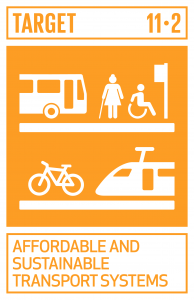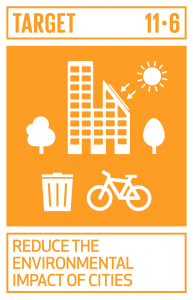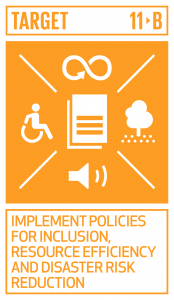SDG 11 – “Making cities and human settlements inclusive, safe, resilient and sustainable” – aims to improve housing, transport, public spaces and urban environments, and strengthens resilience to disasters and climate change.
There are seven targets covering specific areas and three means of implementation targets.1
 |  |  |  |  |
 |  |  |  |  |
Most of the targets and indicators are obviously in areas that the countries themselves have some control over. The last means of implementation target – 11.C, Support least developed countries, including through financial and technical assistance, in building sustainable and resilient buildings utilizing local materials – also relies on donor countries for a successful outcome.
Transition from the MDG targets to SDG 11 in Cambodia
None of the global Millenium Development Goals had a particular urban focus. The MDGs considered wider issues of poverty and hunger, education, gender equality, health issues and environmental sustainability. A 2015 United Nations report described Cambodia an ‘early achiever’, particularly in reducing poverty levels.2
Cambodia developed its own Cambodian MDGs from the global goals. One of the Cambodian goals included targets that specifically addressed urban issues: CMDG 7 Ensuring environmental sustainability. Target 7(b) was to “Increase the proportion of people who have access to potable water supply and sanitation”, and this had specific indicators for both rural and urban populations. Substantial progress was made, with results in the urban populations shown in the table.
Urban targets for CMDG 73
No | Indicator | Unit | 2000 | 2005 | 2010 | 2015 actual |
14 | Proportion of population with access to potable water (urban) | % | 60.0 (1998) | _ | 80.5 | 80.7 (2014) |
16 | Proportion of population with access to sanitation (urban) | % | 49.0 (1998) | _ | 86.6 | 89.0 (2014) |
Once the SDGs were agreed, UNDP conducted a rapid integrated assessment of Cambodia’s National Strategic Development Plan 2014–2018 and relevant sector plans and strategies against the SDG targets.4 For SDG 11 it found 2 targets that were only partially addressed in the NSDP and sector strategies:
- 2 “By 2030, provide access to safe, affordable, accessible and sustainable transport systems for all, improving road safety notably by expanding public transport, with special attention to the needs of those in vulnerable situations, women, children, persons with disabilities and older persons” – UNDP found that while extending transport infrastructure was a clear priority in the NSDP, there was no mention of addressing the needs of those in vulnerable situations.
- 6 “By 2030, reduce the adverse per capita environmental impact of cities, including by paying special attention to air quality and municipal and other waste management” – The NSDP specifies no actions to address issues of air quality in cities. (However, Cambodia has decided to tackle air quality specifically in its localised SDGs, described further down the page.)
UNDP noted that there needed to be more linkages between sectors for the SDGs to be effectively implemented. “SDGs 11.5, 11.6 and 11.7 related to making cities and human settlements inclusive, safe, resilient and sustainable may also need to be addressed by the Environment sector.”5
In the SDG Index and Dashboards Report 2018, in the three areas of SDG 11 for Cambodia where a trend had been perceived, one area was improving and two were getting worse.6 The report found that 71.8% of the urban population had access to an improved water source, and this was getting better. (Water supply is provided by the autonomous Phnom Penh Water Supply Authority and is regarded as relatively successful.) But in air pollution and satisfaction with public transport, the trends were declining.
Localization of SDG 11 in Cambodia
In localizing the SDGs, Cambodia has selected fewer of the global targets and indicators for SDG 11 than for any other goal. CSDG 11 has just one goal and 4 indicators7 (see table), compared to 10 targets and 12 indicators for the global SDG 11. The Cambodian targets are limited to reducing solid waste and air pollution.
Target and indicators for CSDG 11 8
Target | Indicator | 2019 | 2020 | 2025 | 2029 |
11.6 By 2030, reduce the adverse per capita environmental impact of cities, including by paying special attention to air quality and municipal and other waste management
| 11.6.1 Amount of urban solid waste regularly collected and with adequate final discharge (million tons) | 1.33 | 1.35 | 1.43 | 1.50 |
11.6.2 Percentage of the deduction of plastic bags used (%) | 20.0 | 20.0 | 30.0 | 30.0 | |
11.6.3 Percentage of the solid wasted segregated by technical guidance (%) | 55.0 | 55.0 | 70.0 | 75.0 | |
11.6.4 Annual average of the parameters of CO, NO2, SO2, TPS, PM2 and PM10 (%) | 4.0 | 5.0 | 10.0 | 10.0 |
A number of steps have already been taken to improve city environments and services in Cambodia, especially with regard to dealing with solid waste. In April 2018, for example, the Government acted to reduce consumption of single-use plastic bags by requiring supermarkets and general stores to charge customers 10 cents for each plastic carry bag.
In November 2015, a new sub-decree on waste management introduced fines of 10,000–200,000 riel (about $2.50–50) where individuals or business are found dumping or burning rubbish in the public.
Solid waste management falls under the authority of Ministry of Environment at a national level and with city managers at city level. In 2002, a 49-year exclusive agreement was signed between the Phnom Penh City and CINTRI for the company to provide garbage collection services for Phnom Penh. Residents and businesses pay for the service through a charge included in their electricity bills. Phnom Penh has developed a waste management strategy for 2018–2035.9
A 2017 World Bank report found that 100–200 tons of solid waste remains uncollected in Phnom Penh every day, ending up burned, buried, or on open roads. …”.10 Clearly, increasing the amount of waste picked up is an appropriate target to adopt.
Means of implementation for SDG 11 in Cambodia
The first two means of implementation targets for the global version of SDG 11 also apply to some degree to Cambodia’s chosen focus on waste and air pollution:
- 11.A “Strengthen national and regional development planning” is something that the Government acknowledges needs to happen.
- 11.B “More cities adopting integrated plans and policies” around areas including resource efficiency clearly applies.
Cambodia is working to integrate the CSDGs into its wider policies and plans, in particular the National Strategic Development Plan 2019–2023 (yet to be released as of April 2019).
Other key policies and plans with an impact on Cambodia’s CSDG targets, and specifically CSDG 11, include:
- Phnom Penh Master Plan 2035. This “provides broad strategic directions, but does not have detailed land use or phasing plans for implementation…”.”11
- National Strategic Plan for Green City Development (2018–2030) (Global Green Growth Institute and the Royal Government of Cambodia)
- National Strategic Plan for Green Secondary Cities, (jointly with Global Green Growth Institute)
- The Phnom Penh Green City Strategic Plan 2017–2026
- The Sustainable City Strategic Plan 2018–2030
The World Bank has identified three key issues that are constraining efficient urbanisation in Cambodia:
- Lack of clarity in roles and responsibilities
- Poor implementation of plans/lack of institutional capacity
- Unsustainable financing.12
The challenges lead to development coming “…in an uncoordinated and fragmented manner, with infrastructure coming under increasing strain, increases in sprawl and congestion, worsening vulnerability to climate change, and a less livable urban environment.”13
Few details have been published so far about the specific steps that the Government will be taking to ensure progress against the target 11.6 in the CSDGs. The Government has made a general commitment that ministries and agencies will be given support to strengthen their capacity and data systems around measuring and reporting progress.
Monitoring and evaluation of SDG 11 in Cambodia
The Ministry of Planning has overall responsibility for the national monitoring and evaluation, maintaining the CSDG database. The responsibility for specific indicators lies with the relevant ministries and government agencies, who will also be expected to provide a narrative assessment of progress as well as year-end statistics.
For CSDG 11, the agencies responsible for the solid waste indicators are Ministry of Environment, Ministry of Industry and Handicraft, Ministry of Interior, Phnom Penh and the other municipalities (city halls). These are also data sources, joined by Environmental Protection Agency (EPA).
For the air quality indicators, responsible agencies are Ministry of Environment and sub-national administrations. These 2 are also data sources together with EPA.
The indicators for both solid waste and air pollution are shown in the table above.
While Phnom Penh, Cambodia’s capital city and home to almost 2 million people,14 will obviously be a primary focus of the targets of SDG 11, they should also apply to Battambang, the fast-developing city of Sihanoukville and other urban areas.
Related topics
References
- 1. Sustainable Development Goals Knowledge Platform 2018. “SDG 11”. Accessed 15 March 2019
- 2. Heidi Dahles 2016. “Cambodia’s development paradox“, EastAsiaForum, 29 January 2016. Accessed 23 April 2019.
- 3. Kingdom of Cambodia 2018. “Cambodian Sustainable Development Goals (CSDGs)”. Accessed 15 March 2019
- 4. UNDP 2016. “Rapid integrated assessment, Cambodia SDG Profile”. Accessed 24 April 2019.
- 5. Ibid
- 6. Bertelsmann Stiftung 2018. “SDG Index and Dashboards Report 2018”. Accessed 24 April 2019.
- 7. Kingdom of Cambodia 2018. Op cit.
- 8. Ibid
- 9. United Nations Environmental Programme 2018. “State of waste management in Phnom Penh, Cambodia, 2018.” Accessed 24 April 2018.
- 10. World Bank 2017. “Urban Development in Phnom Penh”. Accessed 15 March 2019
- 11. Ibid
- 12. Ibid
- 13. Ibid
- 14. Ibid

